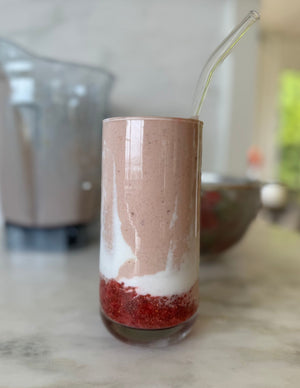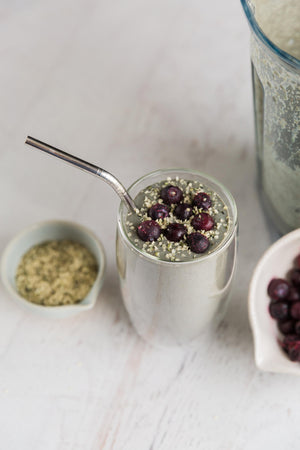Many of us open our news source in the morning and are faced with daunting headlines such as the following "ALERT: Due to highly processed diets, exposure to pollution and pesticides, and a sedentary lifestyle, the average American health span is on the decline." Okay, yes, cellular damage is a real thing and yes, it can lead to chronic age-related diseases. But let's take a BREATH because we are still alive here! I wanted to share with you a simple way to slow down external and internal cellular damage. Many of these suggestions exist within my Fab Four Fundamentals course pdfs.
TL:DR: To slow down cellular aging: 1) Low-impact exercise (2-3x week). No need to motivate for Barry's, just walk; take the stairs. 2) Eating a major mix of deep or brightly colored fruits and vegetables. 3) sleep 4) supplement with Urolithin A. You've got this!
Cellular damage can accelerate the aging process, specifically when it occurs in the mitochondria which generate most of the energy for our cells to function properly. As we age, mitochondrial function starts to deteriorate due to an accumulation of oxidative stress caused by an imbalance of free radicals and antioxidants in your body. Free radicals are unstable and highly reactive molecules with unpaired electrons that play a dual role as toxic and beneficial compounds in the body. Free radicals naturally occur in the body as a byproduct of normal metabolism that assists in killing pathogens and regulating cell growth. But excessive exposure to toxins from external sources, such as
pollution, smoking, alcohol, and pesticides, causes toxic free radicals to form in the body that accelerates cell damage and aging.
How to Defend Against Free Radicals
Antioxidants play an important role in preventing diseases caused by excessive amounts of free radicals. Antioxidants are compounds in plant foods, including pomegranates, dark leafy greens, carrots, blueberries, blackberries, beets, and broccoli. Yum!! These are in so many of my recipes and can be added to any Fab 4 smoothie. The top antioxidant vitamins for cell repair are vitamins A, C, and E.
- Vitamin A results from the break down of a beta-carotene, an essential vitamin for optimizing cellular health and vision. Carotenoids, specifically beta-carotene, lycopene, lutein, and zeaxanthin, work to terminate free radical attacks by binding to them. Think yellow, orange, green!
- Vitamin C is is a nutrient your body needs to form blood vessels, cartilage, muscle and collagen in bones. It is a powerful antioxidant found in plant foods, such as citrus fruits, cherries, yellow bell peppers, and strawberries that can neutralize free radicals and prevent free radical damage.
- Vitamin E refers to tocopherols, a class of antioxidants that inhibits the effects of free radicals in the body. Vitamin E is present in green leafy vegetables and fatty foods such as vegetable oils, seeds, nuts, and egg yolk. Supplementing vitamin E has shown to reduce the effects of oxidative stress and supply cells support to repair properly after being damaged.
The Benefits of Polyphenols and Urolithin A
The vibrant color of antioxidant-rich vegetables comes from a powerful plant compound known as polyphenols that possess various anti-inflammatory, antioxidant, and anti-aging properties. Pomegranates contain the highest amount of polyphenols, including a specific class called ellagitannins, that converts into a rare molecule called Urolithin A (UA). This compound is now available in supplementation form, called Mitopure™ Urolithin A, that allows you to consume a precise amount of UA that supports mitochondria function. Research shows that only 40% of the population produce UA from food sources, which is why I recommend Mitopure for non-producers of UA to access these important anti-aging benefits. Learn more about the benefits of UA here.
Supplementing Mitopure along with regular consumption of polyphenol-rich foods is associated with improved digestion, immunity, and muscle function. In addition, polyphenols play a role in managing blood sugar and protecting our cells against environmental damage that can increase the risk of common chronic diseases.
The Cause of Cell Damage and How to Limit It
Cell damage is often the result of excess amounts of free radicals entering our body through environmental factors, as well as poor diet and lifestyle choices. A diet high in trans fat, sugar, processed foods, frequent alcohol consumption and tobacco use is linked to an increase in free radical production in the body. In addition, exposure to air pollutants, such as nitric oxide, gas emissions, and the ozone layer, and ingesting pesticides and chemicals that are present in water, air, dust, and food can contribute to cellular damage. Because we are unable to avoid toxic free radicals completely, it is important to make changes where we can to assist in preserving healthy cells.
Five Ways to Maintain Healthy Cells
- Regular non-exhaustive exercise, such as walking and weight training, increases antioxidant activities in skeletal muscle, heart, and liver thus limiting free radical production and oxidative damage. In addition, research has shown cardio exercise 2-3x a week in particular increases telomere length, which are strings of DNA sequences in the body that are associated with delayed aging and improved cellular health.
- Getting an adequate amount of sleep is a core function of our health and slowing the aging process. The function of sleep is to defend against oxidative stress through the production of the hormone melatonin, which has anti-inflammatory, antioxidant, and free radical scavenger effects.
- Limiting and managing our stress levels is essential for our long-term health. Your body naturally produces free radicals in response to stress due to high respiratory oxygen intake. In addition, chronic stress has been shown to accelerate the aging process due to an overload of stress hormones, resulting in harmful imbalances in the body.
- Increase your fruit and vegetable intake and consider taking a proven supplement, such as Mitopure, to fill any nutritional gaps. Eating a nutritious diet with antioxidant-rich foods provides the biggest benefits for cellular health. My favorite way to get in more antioxidant-rich foods while regulating my hunger hormones is with Fab Four smoothies.
- Another promising supplement associated with improved cellular health is CoQ10, which is a nutrient that plays a crucial role in how the body produces energy. It serves as an antioxidant, helping to protect the cell from oxidative stress. Our bodies can make CoQ10; however, our capacity to do so declines with age.
Prioritizing antioxidant-rich foods and making healthy lifestyle changes is the key to slowing down the aging process and limiting cellular damage. With a combination of these habits and supplements such as Mitopure, we can assist in preserving healthy cells while reducing damaged ones to increase your health span and lead a longer, more high-quality life.








